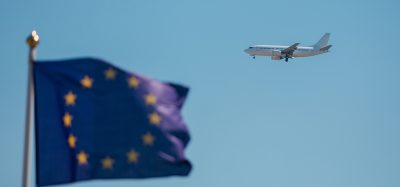Sustainable aviation: Managing the challenge of growth
- Like
- Digg
- Del
- Tumblr
- VKontakte
- Buffer
- Love This
- Odnoklassniki
- Meneame
- Blogger
- Amazon
- Yahoo Mail
- Gmail
- AOL
- Newsvine
- HackerNews
- Evernote
- MySpace
- Mail.ru
- Viadeo
- Line
- Comments
- Yummly
- SMS
- Viber
- Telegram
- Subscribe
- Skype
- Facebook Messenger
- Kakao
- LiveJournal
- Yammer
- Edgar
- Fintel
- Mix
- Instapaper
- Copy Link
Posted: 1 August 2008 | Dan Elwell, FAA Assistant Administrator for Policy, Planning and Environment | No comments yet
Aviation has become an essential element of the U.S. and the world’s economy in the last 60 years. It has made the world a neighbourhood and redefined the nature of opportunity. Aviation is a crucial driver of economic development in large areas of the world and supports the world’s largest industry: tourism, yet aviation’s success has produced concerns over its environmental impacts.
Aviation has become an essential element of the U.S. and the world’s economy in the last 60 years. It has made the world a neighbourhood and redefined the nature of opportunity. Aviation is a crucial driver of economic development in large areas of the world and supports the world’s largest industry: tourism, yet aviation’s success has produced concerns over its environmental impacts.
Aviation has made significant strides in lessening its environmental ‘footprint.’ Over the last 35 years, there has been a six-fold increase in the mobility provided by the U.S. air transportation system. At the same time, there has been a 60 per cent improvement in aircraft fuel efficiency, and a 95 per cent reduction in the number of people impacted by aircraft noise1. However, environmental issues have already resulted in the delay and/or down scaling of certain airport capacity projects over the past decade.
Anticipated increases in air transportation demand will place significant environmental pressures on various segments of the national airspace system. Current operational trends show that environmental impacts resulting from aircraft noise and aviation emissions will be the principal constraint on the capacity and flexibility of the Next Generation Air Transportation System (NextGen) unless managed and mitigated.
For that reason, the U.S. has placed addressing environmental issues at the heart of our Next Generation Air Transportation System (NextGen) plan. We have launched a systematic approach that builds on better scientific understanding, improved models, advanced air traffic procedures, enhanced aircraft technology, alternative fuels and appropriate policy measures to address the coming environmental challenges.
The environmental record
Aircraft noise remains the most significant environmental impediment to airport expansion in the U.S. despite an exceptional record over the past three decades. As Chart 1 shows, in the 30 years between 1975 and 2005 as the U.S. system went from just over 200 million to approximately 730 million passengers, exposure to significant aircraft noise fell by over 90 per cent2.
Much of this improvement resulted from the introduction of the turbofan engine in the late 1960s and early 1970s. Engine technology, which has contributed progressive environmental improvements both in noise and fuel burn, was one of a number of technological and operational improvements that have led to a 50 per cent drop in the average perceived noise from a single aircraft operation3. Yet, as Chart 2 shows, a variety of noise ‘restrictions’ continue to proliferate at airports around the world.
Advances in aircraft engine and airframe technology and better operating procedures have significantly improved aircraft fuel efficiency. The Boeing 777 is 300 times more efficient than the early Convair, Douglas, and Boeing jets4. Since 1985, aircraft energy efficiency has improved more than any other transportation mode, including trains (Chart 3). The efficiency of today’s aircraft is as good as the family car. In fact, if cars and trucks had simply kept up with the energy efficiency improvements of U.S. aviation over the past 20 years, the U.S. would be importing 1.5 million fewer barrels of oil each day.
While aviation remains a small contributor to transport emissions (Chart 4 on page 17), approximately 25 per cent of U.S. commercial service airports are in nonattainment areas or maintenance areas for national ambient air quality standards, including 40 of the top 50 airports. While aircraft noise remains the primary environmental concern in communities across the U.S., air quality has become a growing issue.
As stricter ozone and particulate matter standards are put in place, concerns continue to grow over limiting air carriers’ contribution to nitrogen dioxide emissions (that contribute to ozone production) and other pollutants. Not surprisingly, airports located in air quality nonattainment or maintenance areas increasingly find that air emissions add to the complexity, length and uncertainty of the environmental review and approval of expansion projects.
Compounding concern over air quality issues is a growing focus on the contribution of aviation to climate change. As Chart 5 shows, U.S. aviation greenhouse gas emissions are approximately three per cent of such emissions. While there remain a number of uncertainties5, the potential effects of aircraft emissions on climate change may be the most serious long term environmental issue facing the growth of aviation. This results from the fact that unlike other transport modes, there is currently no alternative to jet kerosene. Without a fossil fuel alternative, aviation’s global percentage of carbon emissions will continue to grow, especially with forecasts for nine billion passengers using air transport by 20256.
The NextGen plan
To meet the challenges aviation’s growth poses in an effective manner, it is imperative that a well-structured and long-term approach is put in place to allow growth while managing environmental impacts. The U.S. is undertaking this through the NextGen Plan. Our objective is to achieve environmental protection that allows sustained aviation growth. The challenge is to achieve a balance between aviation’s environmental impacts and other societal objectives, both domestically and internationally. To realise this, we have put in place a systematic, comprehensive approach.
Firstly, we are improving our scientific understanding and modelling capabilities. For example, with respect to emissions, while CO2’s impacts are understood, our understanding of other emissions impacts, especially at altitude, ranges from fair to poor (see Chart 6). We must gain sufficient knowledge to develop good metrics and appropriate solutions. We are doing this through the Aviation Climate Change Research Initiative (ACCRI), recently launched in partnership with NASA and other U.S. agencies. And because noise remains an environmental concern, we are seeking to develop a more fundamental understanding of noise impacts. For example, we are studying human response to low frequency noise, noise in naturally quiet areas, and aircraft noise characteristics other than loudness.
With regard to decision-making tools in designing aircraft engines, operating the aviation system, or choosing standards or policies, there are trade-offs between many kinds of performance. For example, while the high bypass ratio engine led to reduced fuel burn and CO2 as well as reduced noise, the increases in engine pressure ratios led to increased NOx. In the past, decisions on technology, policies and standards for noise and emissions tended to be ‘stove-piped.’ Today, FAA is building the modelling tools that will allow a more integrated approach to better inform policy makers, help maximise the benefits of proposed actions, guide research investment to optimise payoff, influence design practices, and inform the public about noise and emissions interactions.
Secondly, we are accelerating the implementation of operational improvements to air traffic management to reduce fuel burn. Improving the energy efficiency of the aviation sector has the dual benefit of improving both environmental and financial performance of the aviation sector. We have saved millions of tons of carbon emissions over the past couple of years since establishing Reduced Vertical Separation Minimum in the high altitude structure. We are accelerating implementation of RNAV, RNP and other terminal procedures to further improve the fuel efficiency of the system.
Thirdly, we are taking steps to hasten the development of promising environmental improvements in aircraft technology. This builds upon the fact that the improvement in aviation’s environmental performance in the last three decades is based primarily on enhancements in engine and airframe technology. We currently have legislation before Congress that would create a research consortium focused on accelerating the maturation of lower energy, emissions and noise technology for aircraft.
Fourthly, as part of this technology push, we are advancing alternative fuels for aviation, fuels that improve aviation’s emissions performance at both the local and global level. This not only improves environmental performance but also energy security. The FAA is a major partner in the Commercial Aviation Alternative Fuel Initiative, or CAAFI. This partnership between airlines, manufacturers, airports, petroleum firms and other federal agencies will implement a road map (see Chart 7) to facilitate the use of alternative fuels for commercial aviation. Let me emphasise this isn’t ‘pie in the sky’. We have already seen limited use of coal to liquid fuels in aviation, and some testing and demonstration of renewable jet fuels.
Finally, appropriate policy approaches including market-based measures may offer assistance in managing aviation emissions growth. We are developing goals and metrics for NextGen. Approaches such as emissions trading or carbon offsets may have a role to play. The key is that global market-based measure must respect the prerogative of States to develop and implement the measures they believe appropriate. Attempting a ‘one size fits all’ approach on the international community will only benefit lawyer’s earnings around the world, and not the environment.
International dimension
Aviation is an inherently global activity. An international flight takes off every five seconds. Aviation markets vary from country to country. Consider the U.S and Europe. Consider trends in fuel consumption in recent years. While the U.S. commercial aviation sector has reduced its fuel burn in recent years, European emissions have experienced double-digit growth (Chart 8).
FAA is pursuing international collaboration in a number of arenas. In research, our PARTNER Centre of Excellence has Canadian sponsorship and ongoing research endeavours with seven countries. In air traffic management, there are initiatives underway in both Europe and Asia-Pacific to accelerate the use of air traffic procedures that reduce fuel burn and improve emissions performance7. CAAFI has wide participation from a number of international companies and research organisations.
The International Civil Aviation Organisation (ICAO) is responsible for global standards. It offers the best forum to address aviation’s environmental issues. Although it must guide 190 member countries to consensus decisions, it has achieved a significant record of environmental improvements. Over the last 10 years, it has fostered adoption by the international aviation community of environmental goals in noise, air quality, and climate change, a new noise standard, two increases in NOx stringency for engines, guidance on operational measures to reduce fuel burn and guidance for States that wish to adopt emissions trading. The U.S. strongly supports the current effort of ICAO’s Group on International Aviation and Climate Change (GIACC). We believe it offers the best venue to develop a collaborative, performance-based approach to tackle the critical issue of climate change.
Closing observations
Aviation succeeded in its first century because it constantly met the challenge of innovation; flying faster, safer, quieter and cleaner. The U.S. aviation sector is committed to continuing this record of success on environment. We recognise the imperative to be environmental stewards as we grow the aviation system. We have to manage capacity growth in an environmentally sound manner. If aviation is to grow and continue to benefit the U.S. and the world economy, it will require partnership and shared responsibility: airlines operating quieter and cleaner fleets, airports implementing environmental management systems, air traffic service providers facilitating environmentally effective procedures, government policies and regulatory environment that encourages research and development of new technologies. We believe NextGen puts in place the right framework, built on sound scientific understanding and focused on technology and operational innovation that will deliver the results to ensure environmentally responsible growth during aviation’s second century.


Chart 1


Chart 2


Chart 3


Chart 4


Chart 5


Chart 6


Chart 7


Chart 8
References
- For Greener Skies: Reducing Environmental Impacts of Aviation, NAS (2002)
- The Federal Aviation Administration employs a noise metric of 65 decibels DNL (Day-Night Noise Level) in defining what is significant noise. DNL is a 24-hour, time-weighted energy average noise level based on A-weighted decibel.
- Over the last 25 to 30 years, the average aircraft noise certification level has decreased by 10 dB, which equates to about 50 per cent reduction in perceived noise from a single aircraft operation.
- Colpin, J. and Altman, R., “Dependable Power Reinvented,” AIAA 2003-2882, AIAA-ICAS International Air and Space.
- IPCC 2007
- “World’s Airports Expect 9 Billion Passengers by 2025.” January 30. 2007 Press Release.
- The FAA is working with the European Union through the Atlantic Interoperability Initiative to Reduce Emissions (AIRE) and Australia and New Zealand through the Asia and South Pacific Initiative to Reduce Emissions (ASPIRE). Both these efforts seek to ensure application of enhanced


















